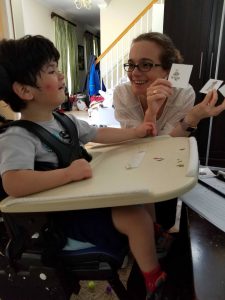 On October fourth MaryAnn Shaw (one of Joey’s grandmothers and a special education professor) and I had the opportunity of presenting our research on Joey at the Pennsylvania Council for Exceptional Children’s conference. Other than this blog this was my first opportunity to share Joey with the world.
On October fourth MaryAnn Shaw (one of Joey’s grandmothers and a special education professor) and I had the opportunity of presenting our research on Joey at the Pennsylvania Council for Exceptional Children’s conference. Other than this blog this was my first opportunity to share Joey with the world.
It was an intimidating task. Although we are tracking Joey’s progress as a single case study, Joey feels like so much more than that. Single case study sounds impersonal and scientific, and Joey is anything but that. He’s an active, engaging four year old. Attempts at remaining scientific are hard because the true nature of working with kids is messy. Things happen. Equipment breaks. Distractions happen. Jokes turn into side tracked lessons.
In the end we decided not to attempt to stay clinical and research-y. Instead we opened the presentation by just sharing Joey – his personality, his loves, dislikes, his medical diagnosis, and his history. He’s a person, and that person is an important part of the story. As I talk about him I want people to love him like I do, but more importantly, I want them to see glimmers of Joey in the kids they work with.
I truly believe the biggest aspect of Joey’s success are the team of people in his life who are presuming competence in his cognitive ability. It would be easy to assume that he had greater restrictions than just motor planning. Yet Joey’s team stops and waits, searches for those glimmers, and follows Joey’s lead and intentions, and makes room for the funny (sometimes sassy) and sweet boy to shine through.
As I discussed the pitfalls and successes we’ve had with Joey’s communication device, and reviewed Joey’s data, I realized I wanted the pre-service teachers in the audience to take away one idea. Never stop believing in a child’s ability. If something isn’t working, change your tactics. If what you’ve always been taught to do isn’t working, try something different. Shift your focus. Re-assess your goals. Re-examine the data and look again at the child in front of you and not the standard methods that traditionally work. Those methods are essential places to start when we’re working with our kids, but when they don’t work, we can’t assume that the problem is the child and not with the instruction. We have to get creative, reach beyond ourselves, and learn something new. You never know when a child may surprise you.


